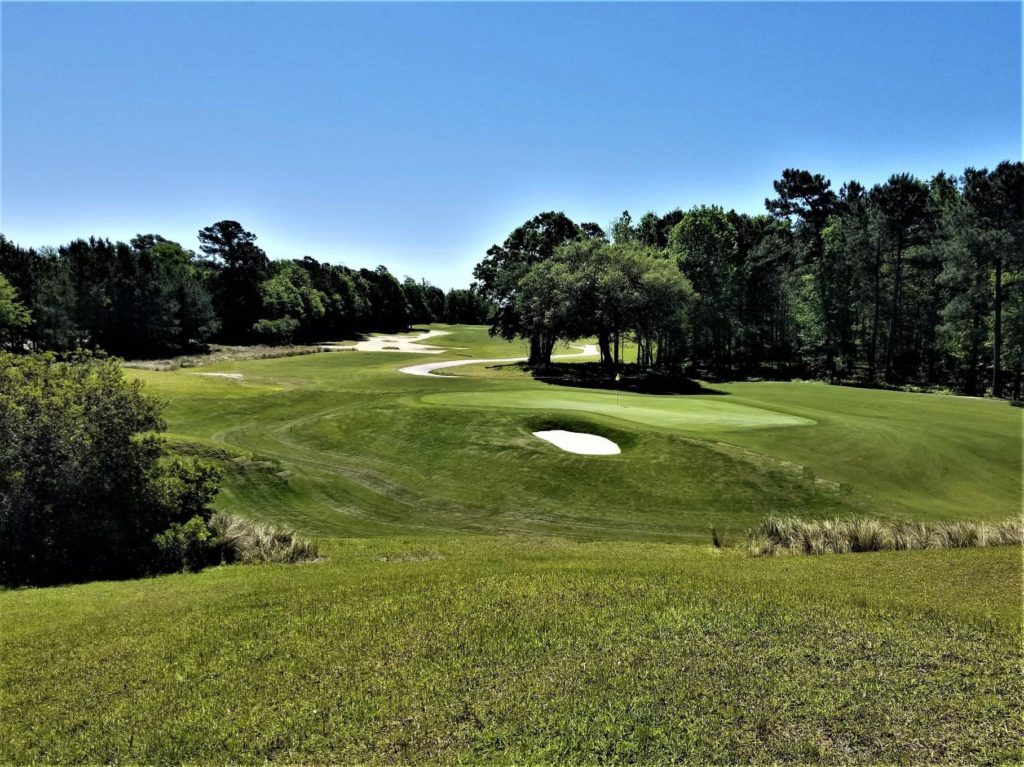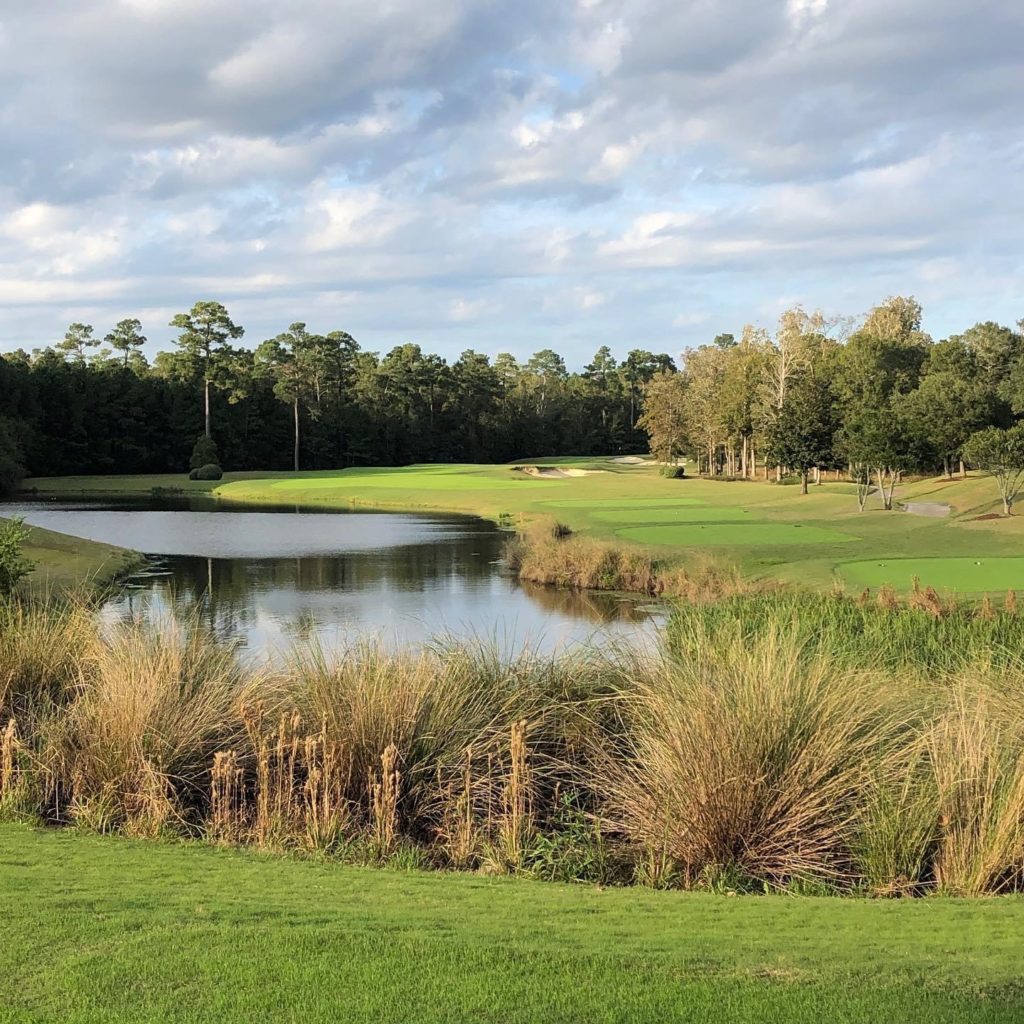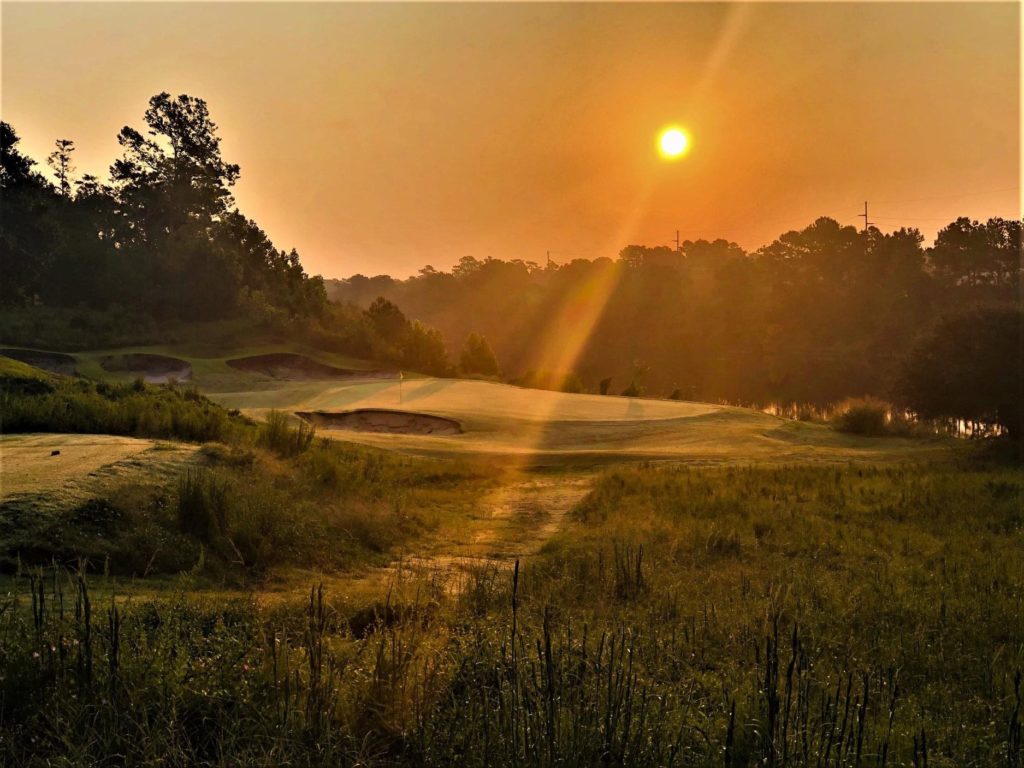
Barefoot Resort’s Dye Course
About the only thing better for a golfer than having a great course at a splendid resort is having two…or three…or even four tracks to play.
And when those courses have been designed by a quartet of different course architects each known for his own style, degree of difficulty and signature flourishes, well, then you may have just found yourself a spot in golf nirvana.
That’s what you get at Barefoot Resort in North Myrtle Beach, renowned for its foursome of famous courses fashioned by Pete Dye, Greg Norman, Tom Fazio, and Davis Love III. Each one of the designers have designed tracks that are individual in their features, visually striking throughout, and a blast to play.
Each golf course at the peerless Barefoot Resort has been ranked as a top track by major golf publications. What’s cool is that each course — just like the man who fashioned it — has its own personality, and that makes for a complete stay here and a heck of a way to get a flavor of the best of South Carolina’s Grand Strand region.
Let’s take a look at the four courses at the Barefoot Resort, starting with…

Barefoot Resort’s Norman Course
Dye’s design takes its pound of flesh
The Dye Course at the Barefoot Resort, is the only semi-private course on the property. It is set off from the other courses on the northern end of Barefoot and is routed through the white sands of the Carolina Bays. Dye puts his imprint on the course throughout, creating a challenge that features difficult angles and ambitious shots.
Mounding, elevation changes and as many as 200 bunkers, only a fraction of them actually in play, are evident throughout the course, which is considered by many to be the most difficult course of the four at Barefoot Resort. Many of the fairway traps are high-lipped and penal. Waste bunkers add defining character and challenge and can be found lining the fairways on many holes.
The Dye Course is a par-72 at 7,343 yards, with a rating of 76 and slope of 143.
Wetland areas come into play on five of the holes, while stands of hardwood and pine trees line the outer edges of the Dye Course. Fourteen doglegs (two of them double doglegs) make golfers work the ball both ways, and accuracy is paramount, especially off the tee.
The 195-yard par-3 sixth and the long and sandy 15th are standouts among the par-3s on the Dye Course, and are strong contenders for signature holes. No. 6 is guarded by water all along the right side, while No. 15 plays at 225 yards from the tips and is surrounded by no less than 30 bunkers, demanding a long, accurate approach to an undulating putting surface.
The 334-yard, par-4 10th, with its lake in play on the left from tee to green, is thought to be the best hole on the Dye Course. The 471-yard, par-4 18th doglegs left to find a pond that will remind you of the final hole of another Dye design – TPC Sawgrass.
If you want to play one of, if not the toughest, course in Myrtle Beach hitch up your britches and tackle the tips at the Dye Course. This course is made for the skilled, thinking player that can shape and place their golf shots.

Barefoot Resort’s Dye Course
Fazio’s course is the most visually stunning
All the courses at the Barefoot Resort knock your socks off for beauty and flawless conditioning, but for many the Fazio Course stands on a taller box for its visuals. Fazio’s layout plays through rolling, secluded terrain that might have you thinking about the classic, inland courses of the Carolina Sandhills.
The Fazio Course, which is carded at 6,834 yards and as a par-71, is well bunkered, but not in an intimidating way. Many of the hazards are placed for visual appeal and only come into play with the most errant of shots. The remaining bunkers are strategically placed to catch wayward drives and misjudged approach shots.
Natural elevation changes add a sense of drama and excitement to the round, with extensive tree cover throughout and water features visible on 15 holes – many of the lakes are in out-of-play areas to ensure playability.
The routing is filled with live oaks, pines, sand, natural areas and native grasses, and the rolling and contoured fairways mean that an even lie is rare. The course does not return to the clubhouse after nine holes, employing an out-and-back routing.
The 13th and 14th holes, both two-shotters, are stunning. No. 13, at 379 yards, appears quite harmless but the drive needs to find the center of a fairway that slopes left. The green is protected to the right by trees and on the left by a sand barge surrounded by water.
Every hole on the Fazio Course has character and appeal. The entire layout has an appeal that all levels of golfers can appreciate. The large, undulating green complexes demand a good short game, as players will be asked to demonstrate nearly every shot in their arsenal.
You’ll need some strategic shot making, good course management, and a little bit of luck to score well but it’s all well worth it.

Barefoot Resort’s Fazio Course
Norman’s course brings the coastal winds into play
The Norman Course is thought to be the real “resort” option on the property because it’s a little easier and more forgiving than the other three. Despite large waste areas and seven holes along the Intracoastal Waterway, Norman’s course at Barefoot is the perfect high-end “starter” course, according to the resort’s website.
The Norman Course plays at 7,035 yards and is a par-72, rating of 74.2 and slope of 141. Sod wall bunkers will be seen throughout the course and bump-and-run shots often provide an effective and necessary means of getting the ball onto the putting surfaces.
When playing this golf course, be sure to have your sand wedge handy as there are approximately 60 sand bunkers around the course that will pose some problems to many people with their sloping white faces and occasional sod walls. The green complexes are slightly raised, but there is often ample room for error and recovery shots.
There are enough hazards to challenge the best of players, and the surrounding environment makes this a pleasant golf experience for all levels of players.
The par-5 ninth, with a creek fronting the green complex, is one of the more beautiful and challenges, and the back side has several memorable holes. Elevation comes into play as the beautiful par-5 15th plays uphill while the following par-3 plays noticeably downhill approach over a creek.
Because of where the Norman course is situated on the property, it gets buffered by ocean breezes – enough to be considered the resort’s “beach” course.
The direct line from the Atlantic Ocean to the Intracoastal can show its teeth on several holes, although the 203-yard, par-3 10th may be influenced the most. Regardless of which tee you play, 40-yard-deep putting surface slopes ever-so-slightly toward the Waterway.
Avid golfers always hope to be greeted by a special closing hole, and Norman produces one here with the 552-yard par-5 18th. The hole is reachable by the stronger players in two shots, but a crowned green will hold only the very best of shots. It’s a pristine finish to a magnificent game of golf.
The Great White Shark did a wonderful job of maintaining much of the natural landscape when designing this course. Significant attention is placed on the waste areas and natural grasses, leaving only 60 acres of turf to be manicured. There are undisturbed trees and wetlands at nearly every hole, and the entire experience is memorable.

Barefoot Resort’s Norman Course
Love Course is the best of all worlds here
To their credit, Love and his brother/design partner Mark Love didn’t attempt to come up with some tricked-up track that might impress his fellow architects at Barefoot Resort. Instead, the Loves give golfers the freedom to grip it and rip it; indeed, the driver is your best friend at this layout.
Love used all of his experiences as a background and then embraced a tradition of Lowcountry character in the design of this course. The result is a traditional track that incorporates the re-created ruins of a 17th Century plantation, similar to those found in Scotland and Ireland, generous landing areas and demanding greens complexes. Extending 7,047 yards from the tips, the par-72 venue is rated 74.9 and sloped at 141.
Barefoot’s Love Course has plenty of risk-reward options as 13 of the 18 holes give you the option of taking a more direct, danger-filled path to the green or to play it scorecard safe.
For example, the 294-yard, par-4 fourth can be driven but the fairway extends up a ridge to the base of the re-created ruins of an old Plantation house where slaves were kept. The ruins are completely fake – they date back only to 2000, but their broken, standing brick walls and stone columns, some completely covered in ivy, can be a real pain if your approach is a little long.
This course is replete with nice touches: the sixth, a 403-yard, par-4 curves around the waterway and heavy bush area, has low-lying brick walls right below the green. The wall forces a slightest elevation on your iron approach and yet creates a lot of interest.
The difficulty in the Love Course comes in the putting surfaces, which are known for their crowned configurations. The greens are very much in the Donald Ross style, and, as with most of Ross’s courses, short is definitely better than long. Adding to the discomfort, most sides are shaved to draw shots into collection areas.
The best of the fine set of par 3s is the 235-yard ninth, which features a forced carry over a wetland. The best hole on the course is arguably the 552-yard eighth, with a fairway marked by a bunker some 275 yards out by the left center of the fairway. A good safe drive to the right of the bunker leaves a long approach over an environmental area to an elevated, well-trapped green. It’s a marvelously designed hole with strong visuals.
Some of the trouble on the Love Course is more perceived than actual. Bunkers appear to sit near greens but don’t, and plateaus false-front some putting surfaces. Love puts bunkers in your face on the 450-yard par-4 seventh. And beware of the waste bunkers and the tricky, left-sloping fairway on No. 14.
The track is not overly long by today’s standards, but there are still some monsters. No. 5, a 463-yard par 4, is a devilish dogleg-right that mandates a left-to-right drive. Don’t over-cut your drive as a lake is waiting. More water and fairway bunkers make reaching the green in two quite difficult.
The Love Course‘s ultimate hole, a 596-yard par 5, features a fairway that narrows to a slit and an intimidating approach to a green guarded by water on the left.
Competing with other architects in the Barefoot Resort project, Love was determined to build a course that was unique, visually striking and fun. The PGA Tour veteran was good on all accounts as this is one of Myrtle Beach’s most popular courses since it opened in 2000.
An entire golf vacation could be spent at the 2,377-acre Barefoot Resort and nothing that the Myrtle Beach area has to offer would be missed.
Each course carries its own stellar reputation, and debate aplenty are contested in deciding which is better and which is best. The combination of talented architects has created phenomenal opportunities for some terrific golf excursions.

Barefoot Resort’s Love Course

